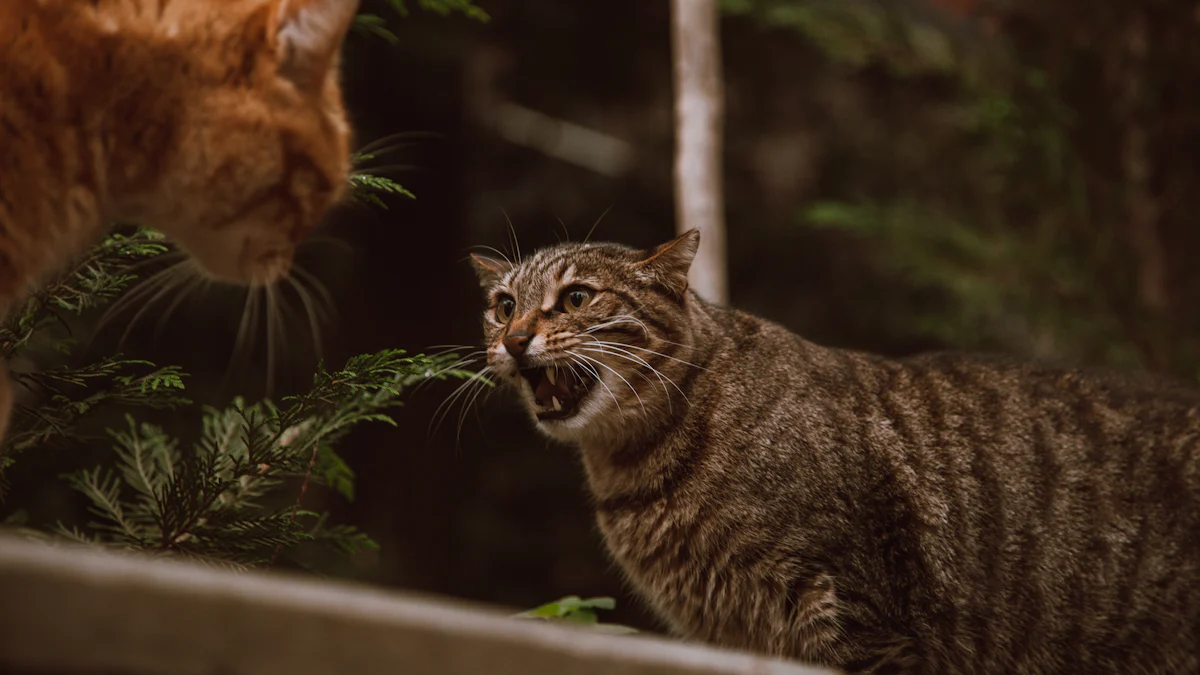Buy One, Get One FREE
Understanding and Stop Cat Fighting with Neighbors Cat

Cat fights with the neighbor's cat can be a significant issue. These altercations often arise due to territorial disputes or excessive aggression. Male cats typically want to assert dominance, leading to more conflicts. Finding ways to stop cats from fighting with the neighbor's cat ensures the safety and happiness of all felines involved. Creating a peaceful environment benefits your cat and the surrounding area. Learning how to stop these fights can prevent injury and anxiety. Understanding the root causes of these fights helps in discovering effective solutions.
Why Do Cats Fight with Neighbor Cats?

Territorial Instincts
Understanding territorial behavior in cats
Cats like to have their own space. They choose areas they feel safe in. Cats use scent glands on their face, paws, and tail to mark these areas. This marking tells other cats to stay away. But fights happen when another cat enters this space. Male cats are often more aggressive about their territory. They want to protect where they live.
Signs your cat is being territorial
Knowing when a cat is territorial can stop fights. Signs include spraying urine or scratching things. Cats might hiss or act mean to others who come near. Walking back and forth by windows shows they feel threatened. Watching for these signs helps prevent problems early.
Social Hierarchies
How social hierarchies affect cat interactions
Cats have leaders in groups that decide who gets food or spots first. Bossy cats take charge of these things, while others step back to avoid trouble. New cats can upset this order, causing tension and fights.
Recognizing dominance and submission in cats
Seeing which cat is bossy or shy helps manage them better. Bossy cats stand tall and look straight at others, sometimes swatting them away. Shy ones crouch low and avoid looking directly at others, even rolling over to show they're not a threat.
Lack of Socialization
Importance of early socialization in cats
When kittens meet different places and animals young, they learn well. These kittens grow up calm around new friends because they're used to it.
Identifying poorly socialized cats
Cats that didn't meet many others when young might be scared or mean now. They hide or hiss at new animals but can learn with time and patience.

How to Stop Cats Fighting with Neighbors Cat
Making a Safe Place
Creating a safe and secure environment for your cat is crucial in preventing conflicts with the neighbor's cat.
Setting Boundaries for Your Cat
To reduce the likelihood of fights, it's essential to establish clear boundaries. Consider installing a tall fence around your yard to keep your cat safely contained while preventing other cats from entering. Regularly inspect your fence for any holes or weak spots that might allow escapes. Additionally, motion-activated sprinklers can be an effective way to deter other cats from entering your yard without causing harm. These measures create a secure area where your cat can roam freely without the threat of a confrontation.
Giving Safe Spaces Inside
In addition to outdoor safety, ensure your cat has plenty of safe spaces inside your home:

Designate multiple cozy beds and litter boxes in different areas of your home to reduce territorial stress.
Provide high perches, such as shelves or cat trees, so your cat has a place to retreat and observe from a distance.
These safe zones help your cat feel secure, reducing anxiety and the likelihood of aggressive behavior.
Slow Introduction Steps
Introducing your cat to a neighbor's cat should be done gradually to avoid aggressive encounters.
Introducing Cats Slowly
Start with visual introductions by allowing the cats to see each other through a window or screen door.
Swap their bedding or toys to allow them to become familiar with each other's scent.
When ready for face-to-face meetings, choose a neutral area and keep interactions brief and supervised.
This gradual approach helps the cats adjust to each other and reduces the risk of confrontation.
Watching Interactions for Safety
Supervise all interactions closely, watching for signs of aggression such as hissing, growling, or swatting.
If tension escalates, separate the cats immediately to prevent a fight.
Use positive reinforcement, like treats, to reward calm behavior during these interactions.
This method helps both cats associate the presence of the other with positive experiences, reducing future conflicts.
A slow and controlled introduction is key to preventing fights. Start by allowing the cats to see each other through a window or screen door. This visual introduction helps them become familiar with each other’s presence without direct contact. You can also swap their bedding or toys to allow scent sharing, which can help in building familiarity. When the time comes for face-to-face meetings, choose a neutral area and keep the initial interactions brief and supervised. This gradual process minimizes the risk of confrontation and helps the cats adjust to each other at their own pace.
Using Good Rewards
Positive reinforcement is a powerful tool for encouraging peaceful interactions between cats.
Rewarding Calm Actions

Offer treats or affection whenever your cat remains relaxed and non-aggressive near the neighbor’s cat.
Consistent positive reinforcement helps reinforce good behavior, teaching your cat that calmness leads to rewards.
Over time, this can foster a more peaceful coexistence between the two cats.
Training to Lower Anger
Training lowers anger and stops fights with neighbor's cat. Use toys to distract during tense times. Teach "sit" or "stay" commands to change focus. Practice often helps manage anger and create harmony.
Preventing and Managing Cat Fights in the Neighborhood

How Can I Stop My Neighbor's Cat from Attacking My Cat?
To stop fights, make a safe space for your cat. Build high fences to keep other cats out. Use sprinklers that turn on when they sense movement. Talk with your neighbor about sharing outdoor time. This plan helps avoid fights by taking turns outside. Neutering calms your cat by reducing aggression. A peaceful home stops cats from fighting.
How Do I Stop My Cat From Fighting Other Cats?
Stopping fights needs patience and watching your cat closely. Look for stress or anger signs in your cat. Give toys and fun activities inside to keep them busy. Reward calm actions with treats and praise. Slowly introduce them to other cats, watching carefully. Safe spots at home let them relax away from others.
Is It Normal For Neighborhood Cats to Fight?
Cats fight over their space because it's natural for them. They defend where they live, especially male cats who are more aggressive. Knowing this helps you manage it better. Regular outdoor times reduce clashes between cats. Use a FELIWAY Diffuser to calm anxious ones with special scents. Indoor fun stops them from wandering too much.
Extra Things to Think About

Stopping Fights Before They Start
Making Clear Boundaries
Clear boundaries help stop cat fights. Build a tall fence to keep neighbor cats out. Fix any holes in the fence so no one escapes. Use sprinklers that turn on when they sense movement to scare away other cats. These steps make your yard safe for your cat.
Setting Up Safe Spots for Cats
Safe spots inside reduce stress and fighting. Give your cat many places to rest and hide. Make sure there are quiet spots for them to go when scared. Use special sprays that calm cats down. These things help stop fights from happening.
Lowering Stress Levels
Giving Many Resting Places
Many resting places give choices and lower stress. Put cozy beds all around your home. Have lots of water bowls so your cat drinks enough. Separate eating spots stop food fights. These setups make home peaceful.
Having Enough Litter Boxes
Enough litter boxes stop territory fights. Have one box per cat, plus an extra one. Put them in quiet, easy-to-reach places and clean often. Good litter box care lowers stress and stops fighting.
Making Indoor Spaces Better
Playing with Fun Toys
Fun toys keep your cat busy inside. Use puzzle feeders to challenge their brain. Play with wand toys like they're hunting prey. Change toys often to keep them fun. Busy cats don't get bored or fight.
Building High Places for Cats
High places let cats escape and watch things safely. Install shelves or trees for climbing up high. Give window seats for watching birds outside. High spaces make cats feel safe and help avoid fights by giving calm spots.
Knowing why cats fight helps make things calm. When you understand the reasons, you can fix them. Stop fights by making clear boundaries and giving rewards for good behavior. Experts say spaying or neutering makes cats less aggressive. Let your cat meet neighbor cats slowly. Use safe areas and toys to keep them relaxed. These ideas help cats get along better. Your work will make your cats happier and healthier.



















